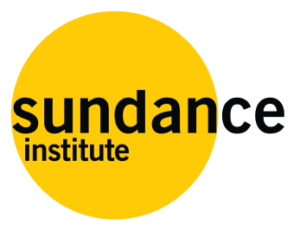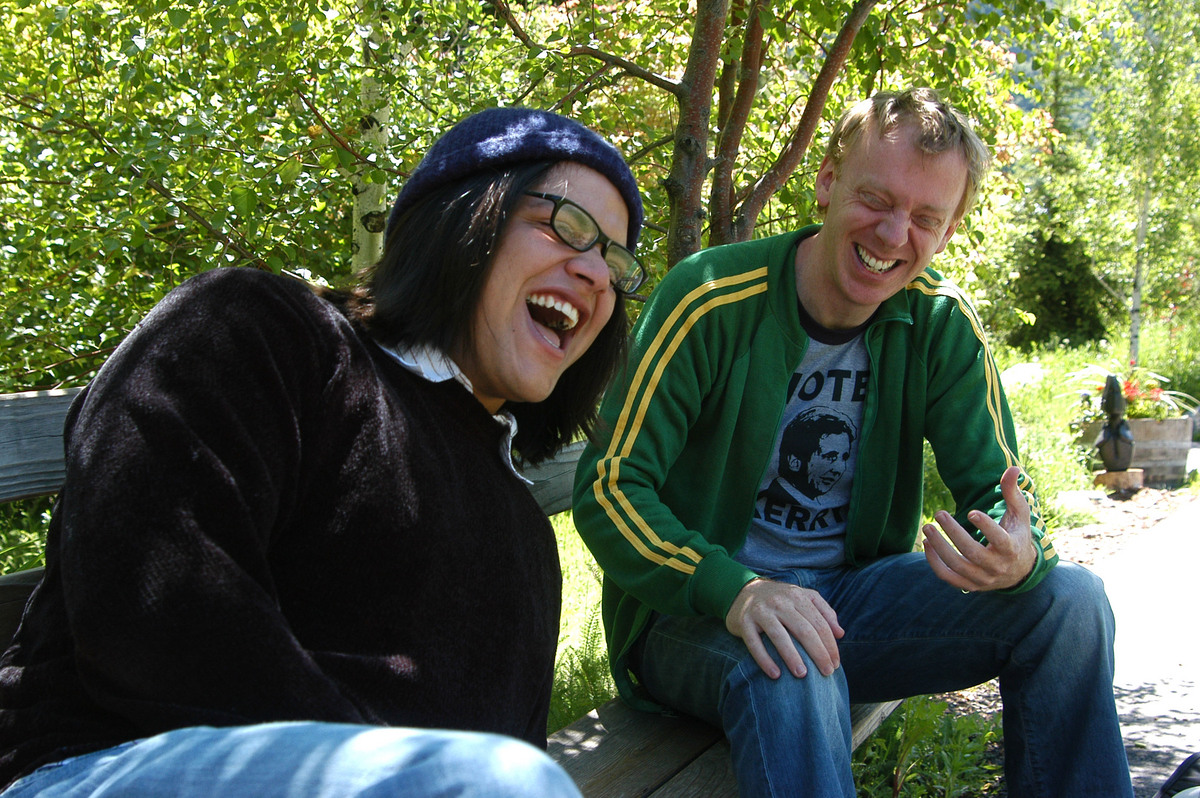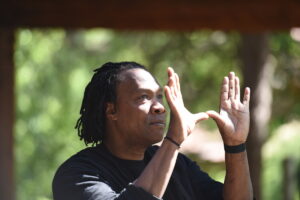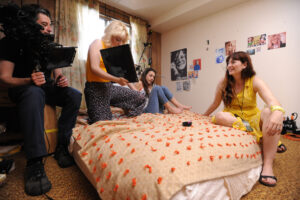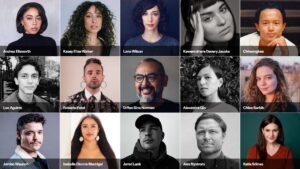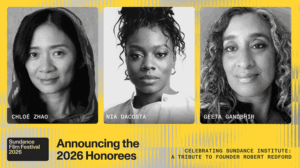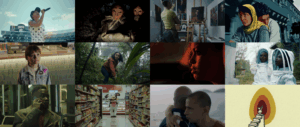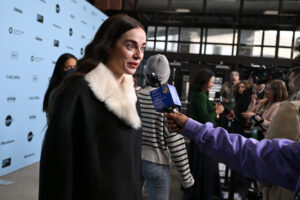Director Sterlin Harjo and creative advisor Mike White at the 2004 Screenwriters Lab.
By Jessica Herndon
As the Sundance Institute Directors Lab turns 45, we’re celebrating this milestone by highlighting filmmakers who are an integral part of its legacy. Through this special series, we dive deep into the stories of directors who began their narrative feature filmmaking journey at the lab and went on to make an indelible mark on cinema. To ensure future fellows have access to this formative space, we invite you to make a gift and join us as we champion independent voices by keeping the labs alive.
While Sterlin Harjo was a film student at the University of Oklahoma, N. Bird Runningwater, producer and former Director of Sundance Institute’s Native American and Indigenous Program, appeared as a guest speaker at his college. Not one to pass up a chance to make a connection, Harjo introduced himself to Runningwater. “I told him that I wanted to make films,” he remembers. “And he said, ‘Cool, let’s do that!’”
For Harjo, Runningwater’s encouragement was like hearing someone say, “Let’s make your dream come true,” he recalls while chatting via Zoom from Tulsa, Oklahoma, between edits of his upcoming series, The Lowdown. While lightly tugging on his alligator teeth necklace, he adds, “That was the very first interaction with anyone from Sundance, and it instilled the confidence in me to keep going and move forward in the filmmaking process.”
From that moment on, the filmmaker never looked back. By 2004, Harjo was immersed in the Sundance Institute Directors Lab, working on his directorial debut Four Sheets to the Wind. The drama follows Cufe Smallhill (Cody Lightning), a young Seminole/Creek man who travels to Tulsa to stay with his estranged sister, Miri Smallhill (Tamara Podemski), after his father commits suicide. Premiering at the 2007 Sundance Film Festival, Harjo’s film, which received the Special Jury Prize for Acting for Podemski, earned critical acclaim for its poignant exploration of family, loss, and self-discovery within the context of contemporary Native American life.
The project set the tone for Harjo’s later work. From his 2009 drama Barking Water to his 2014 documentary This May Be the Last Time and his award-winning series Reservation Dogs (created with fellow lab alum Taika Waititi), Harjo’s strong cultural ties are woven throughout, grounding each project in a rich, authentic Indigenous perspective.
“As someone coming from rural Oklahoma, becoming a filmmaker seemed so far away,” says Harjo, adjusting his orange-tinted glasses and twirling the rainbow loom bracelet his daughter made him around his wrist. “The Sundance lab showed me that it’s not,” he adds with a smile. “There was access and proximity that I didn’t have, but I learned that if I wanted to [make films], I could do it — and I was no different from other amazing filmmakers.”
Below, Harjo discusses the techniques he learned to effectively communicate with actors, why honoring your authentic voice is key, and how the Sundance Institute community — where he’s been a Native Filmmakers Lab creative advisor and Sundance Film Festival Short Film Competition juror — has helped him purposefully navigate his career in the entertainment industry.
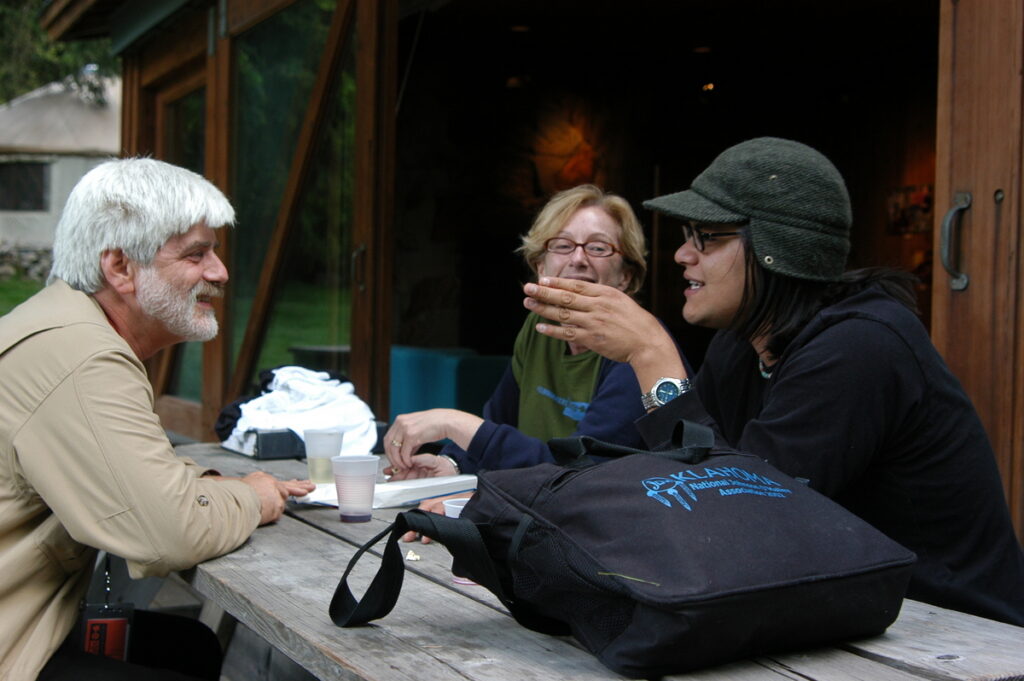
How did the Directors Lab help build your confidence as a director?
For me, it was everything. You had Gyula Gazdag and Michelle Satter coaching and facilitating. I had [Robert] Redford coming into my editing suite, and you just see how smart these people were. And also people like Ed Harris taking your work seriously. Philip Seymour Hoffman read parts of my script during the script reading, and we were riding in a shuttle together afterward, and we were talking about our kids, and he told me that this monologue that I wrote was really beautiful, which coming from him, it’s a really big deal to a young filmmaker that loves the actor.
These legendary people taking me seriously, looking at my work, treating me as a filmmaker and an equal, and allowing me to be at the table with the people I looked up to was a big deal. They saw something in me that they thought was worth spending their time on. Having Sundance be this place where it’s like, ‘We do want to hear what you have to say. We think it’s important to support voices that are not usually heard from in this industry.’ Having your work taken seriously in an industry where you feel like no one cares what you have to say was just everything. That gives you so much confidence. It was the confidence that I needed at that time.
What did you learn during the lab that you’ve continued to use throughout your career?
Joan Darling did an acting workshop that included little things I still use to this day. One of the things that she would tell us is before you talk to anyone on the technical team, say something to the actors first — acknowledge them. Let them know that you’ve got their back, and that builds this trust. Also, take an actor aside or whisper directions instead of yelling in front of everyone. That’s helped so much.
What did you learn about yourself that surprised you during your time at the lab?
That you have to have the confidence to fail — that’s the main thing I took away. It’s like having the strength to fail and keep going, to realize it’s a process. The labs are very much about process, and if you can navigate that process and turn yourself over to it, then you can get further and grow as an artist. I feel like I’m still in that process of gaining confidence and believing in myself, and working towards making everything that I do better. That started at Sundance.
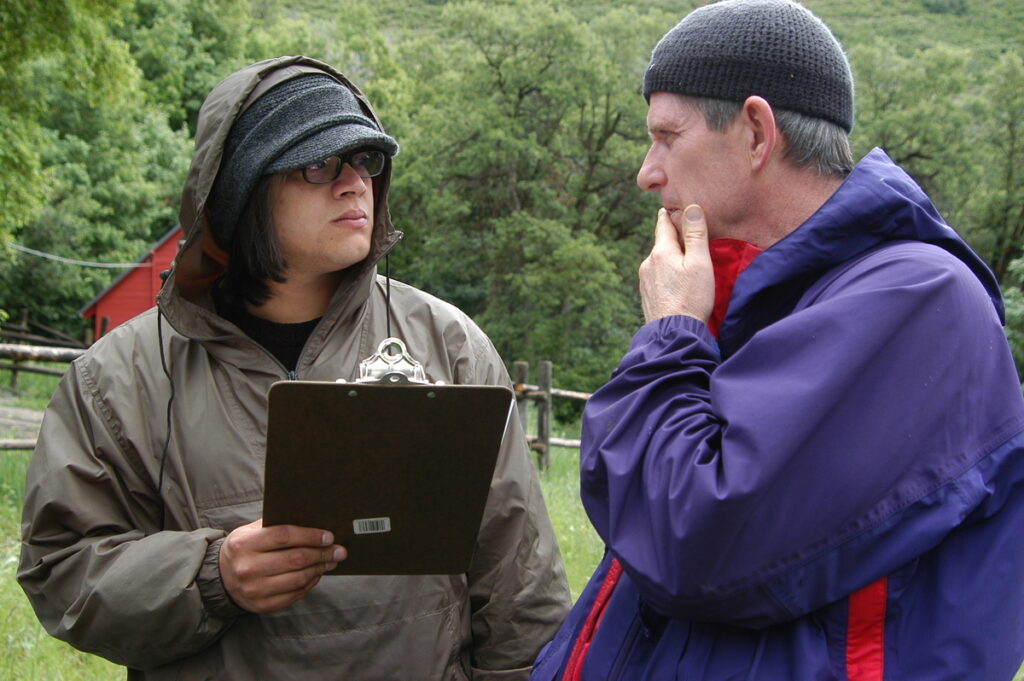
How did the lab shape the way you view your role as a storyteller and director within the broader film and TV industry?
What it really helped with is that it showed me this industry can also be a community — one that nurtures other filmmakers — and it doesn’t have to be cutthroat. It doesn’t have to be; I step on you to get somewhere. All of these people were generous with their creativity and their time to help me because they believe in this medium. And in turn, I’ve done that; I teach workshops and teach for the University of Tulsa. I am constantly bringing other filmmakers into DIRECTV for the first time or giving people a chance to be on the crew. It reinforces what I want out of this industry, which is community and creating something bigger than us, but doing it together. It’s a collaborative art form, and [the lab] reinforced that.
How did the lab and your experience with the Sundance Institute community set the tone for how you’ve navigated within the entertainment industry?
You quickly realize there are people in this industry for many different reasons. The difference at Sundance is that all these people are helping, working, volunteering, and making this happen. They’re there because they love cinema, storytelling, and interesting voices, and they support independent voices. Once you get out of Sundance and you go to meetings in LA, and you’re trying to get your film made, things are very different. They’re not treating you necessarily like Redford, Michelle Satter, and Bird Runningwater. You quickly learn what you had, and you miss that experience, but you also take it with you and help change this industry.
You’re able to carry on that attitude as you mentor and help others. You can talk to anyone on my crew; it is like that. It’s very much a community. A lot of that goes back to my days at Sundance labs.
Was the lab an essential part of your journey as a filmmaker?
I wouldn’t be doing this without it. It was my boot camp for real. It helped me because I was going from having never worked on a film set to being a director, and I needed to know everything — what we did, the different positions, and also how to work with the crew. It was great.
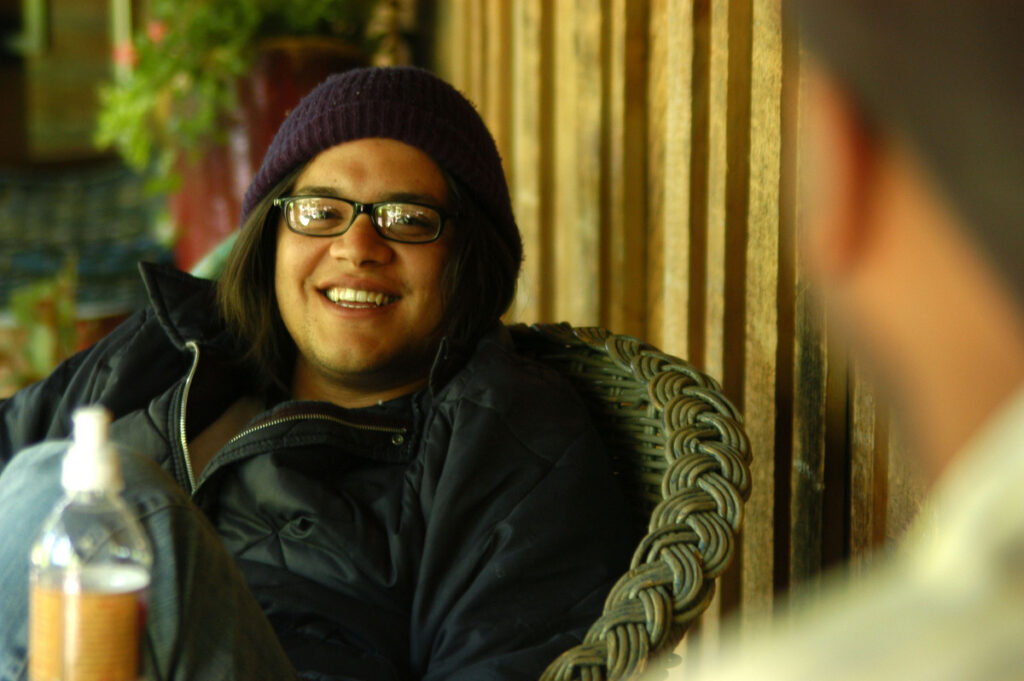
What advice would you give to up-and-coming filmmakers who are hoping to attend the lab in the future?
Don’t be frustrated if you don’t get in right off the bat. I didn’t get in right off the bat. I got in the second year I went for it. And don’t be afraid to tell your story in a way that you want to tell it. That’s what they’re looking for; voices that are singular. And sometimes, I think people try to tell their stories and write scripts that fit some sort of box or what they’re seeing on screen or TV, but the script that I had had never been. There was nothing like that on TV, and I continued to do work like that, and eventually, it paid off.
It was knowing I had these people rooting for me and a community that started at Sundance, which believed in me, that helped me keep going. I remember I was thinking about moving to LA, and I told Michelle Satter, and she said, “Don’t do that.” She’s like, “Just make your films where you’re at.” I’m really glad she said that.
How did your experience at the lab inform the kind of stories that you’ve gone on to tell?
It reinforced that my stories were important to tell. I mean, I had Walter Mosley, a legend, telling me, “I like your story. This story’s awesome, man. It reminds me of things in my life.” And Walter wrote on my last show, so I got to hire my mentor, which was amazing.
I think, again, just them taking me seriously and telling me that my stories were important and them rooting for me was enough to really go, “Okay, I’m onto something.” And I made a few films before Reservation Dogs, which I guess put me on the map. But it was that spirit of the labs and independent filmmaking that took me through.
